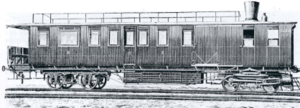SAE No. 1 and 2
| SAE No. 1 and 2 | |
|---|---|
|
circa 1883
|
|
| Numbering: | SAE No. 1 and 2 |
| Number: | 2 |
| Manufacturer: | Machinery: Borsig , wagon part: Herbrandt |
| Year of construction (s): | 1883 |
| Type : | B'2 'h2v |
| Genre : | BCPw4idT |
| Gauge : | 1435 mm ( standard gauge ) |
| Length over buffers: | 14,000 mm |
| Bogie axle base: | Machine bogie: 1,830 mm, running bogie: no details |
| Service mass: | 15,000 kg |
| Top speed: | 25 km / h |
| Starting tractive effort: | 19 kN |
| Driving wheel diameter: | 800 mm |
| Number of cylinders: | 2 |
| Cylinder diameter: | 230 mm |
| Piston stroke: | 330 mm |
| Boiler overpressure: | 13 bar |
| Grate area: | 0.62 m² |
| Evaporation heating surface: | 19.72 m² |
| Seats: | Originally 2nd class: 16, 3rd class: 38 from 1896 2nd class 14, 3rd class 41 |
| Classes : | 2nd / 3rd |
The SAE No. 1 and 2 were four-axle steam railcars of the Schleswig-Angeler Eisenbahn-Gesellschaft (SAE). They were manufactured by Borsig (machinery) and Herbrandt (wagon part) according to the Rowan system and were used in the company's passenger transport.
With these two vehicles, a freight railcar was delivered to the company, about which no descriptions exist.
The SAE steam railcars were in operation until 1902 and were used as sidecars until 1920.
history
The vehicles are a design by Borsig, who from 1876 dealt with the construction of steam railcars and acquired the license to build rowan cars in 1880. By 1891, the company had manufactured 85 three- and four-axle cars based on this design principle.
The two SAE vehicles were assembled at the Herbrand wagon factory in Cologne-Ehrenfeld . After completion, they were transferred to Schleswig on state railway lines . The vehicles needed around 1.2 tons of coal to drive the 607 km.
Initially, the steam railcars and the freight railcars procured at the same time were sufficient for the transport volume. With increasing traffic, the steam railcars reached their performance limits, which is why steam locomotives were procured with car trains from 1894 and the railcars migrated to subordinate services. In addition, their running characteristics were unsatisfactory, to which the existing lightweight superstructure contributed. Nevertheless, they received a repair with the installation of a new machine system.
After Lenz & Co. had taken over the management of the private railway, the steam railcars were converted into passenger cars with 100 seats in 1902/03 and used until 1920. A car body served as a shed until 1959 and was then scrapped.
technical features
The car body was based on a passenger car design and redesigned for the needs of the steam powered rail car. It consisted of a 3rd class compartment with 38 seats and a 2nd class compartment with 16 seats as well as a post and luggage room with a capacity of 5.6 m², a lockable room for the post of 1.4 m² and the room for the machine system with a floor area of 8.7 m². The 2nd class compartment was accessed through a side door approximately in the middle of the car; there was no passage to the 3rd class compartment. The car had a large side car door in the post / luggage area.
The machine system was designed as a two-axle bogie with a vertical tank . The cylinders were positioned at a slight angle at the front and acted on the second axis of the bogie. The first axle was driven with a coupling rod. The wheels of the machine frame were designed with internal bearings and mounted on springs. The secondary suspension was designed with a leaf spring . The running bogie was designed with an external bearing. For maintenance and repair work, the machine frame could be separated from the car body and extended to the front.
Individual evidence
- ↑ a b c Ludger Kenning: Back then at the Schleswig circular railway . Kenning, Nordhorn 2017, ISBN 978-3-944390-02-4 , pp. 8-9 .
